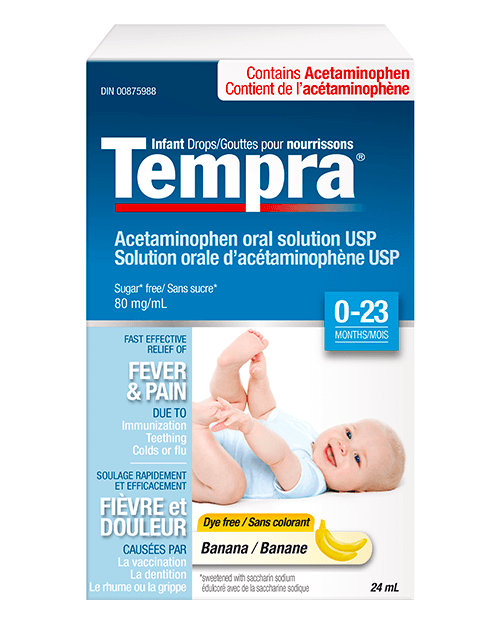How do you alleviate pain and fever in children?
Every parent has had to deal with their child's pain or fever at one time or another, whether your little one suffered from an ear infection, the flu or a toothache. When the thermometer jumps above 37 C (98.6°F) or the illness lingers, you want quick relief. To ensure you have the best remedies on hand, Familiprix, Tempra and Vie de Parents have a few solutions for you to help your little ones feel better.
What is pain?
Pain is a sensation as well as an emotion. A child who trips and falls while running with their friends may feel the pain of the fall and the pain of being the last to cross the finish line. For some children, the physical pain for the same fall may be less than for another child, but the emotional pain greater. Pain is difficult to define because it’s personal and subjective.
Some children have less tolerance for pain, while others hold it inside and express it later for fear of having to go to the doctor, if the last visit was more traumatic.
In any case, any time the pain is so severe that it prevents your child from enjoying their daily activities, it should be treated.
Why is pain sometimes accompanied with a fever?
In the event of infection or illness, the body's defense system causes the body's temperature to rise. This is most often associated with colds, flu, ear infections and chickenpox. It can also increase after a vaccination. If the fever persists, medication could be required.
It’s important to remember that children under three months of age who have a rectal temperature above 38°C (100.4°F) should be seen by a doctor. The same goes for a child who has a fever for more than three days, has pain for more than five days, or has new symptoms.
How do you relieve the pain?
There are many ways to relieve pain, and some can be combined. Some health professionals speak of the “3 Ps,” which are psychological, physical and pharmacological intervention.

Non-medication methods
The first two "Ps" stand for "psychological and physical interventions." They are often the first steps in pain management.
A reassuring presence
Either that of the parent, a significant other or their blanket. Comfort and support are often the solution to many ailments. For babies with colic, skin-to-skin is often a solution. For teething, cuddling your child will take their attention away from their pain.
Cold or heat
The application of cold can be useful for pain due to sprain, trauma, bruising or teething. Conversely, a warm compress is beneficial for muscle pain, stomach pain or back pain.
Relaxation
Deep breathing techniques, bathing, drinking plenty of water, and clearing your mind can all make a difference. For children two years and over, diffusing essential oils of lavender, mandarin (promotes relaxation and sleep) or eucalyptus (stimulates the immune system, decongests the respiratory tract, cleanses the air) is a good addition to non-drug remedies. For toddlers two years and under, the diffusion time is up to five minutes per day. For children between two to six, the duration can be up to 10 minutes.
Pain medication
The third “P” stands for “pharmacological intervention”, so pain is managed with medication. There are four types: topical anesthetics and adjuvants, opioids, and non-opioid pain relievers. We are focussing on the latter here because they’re the most common, easiest to use, and over-the-counter drugs.
Non-opioid pain relievers are actually acetaminophen or ibuprofen. They’re generally used to fight headaches, ear infections or toothaches. They’re also given to lower fever or reduce pain after a vaccination. Ibuprofen, which has an anti-inflammatory effect, is appropriate for musculoskeletal pain or cramps.

There are a variety of non-opioid pain relievers. Tempra is a great acetaminophen product for toddlers because it's both a pain reliever - to relieve pain - and an antipyretic that lowers fever. Infants can take it as a drop, and it can be administered directly into the mouth for quick and effective relief. Children two years and older can have syrup. But in order for toddlers to enjoy taking their medication, you need fun flavours. Tempra products are available in two flavours to help your child better regain their energy and smile!
Some of these products may not be suitable for your child. Always read the label and follow the dosage for your child's age and weight. If in doubt, ask your health profesionnal.
Sources
https://www.thechildren.com/news-and-events/latest-news/easing-childrens-pain
